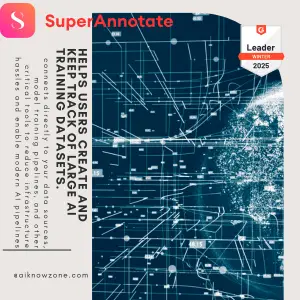SuperAnnotate AI
SuperAnnotate AI review: Streamline your data annotation workflow with this powerful platform. Learn about its features, pros, cons, and pricing.
Description
Introduction
So, I recently dove headfirst into the world of SuperAnnotate AI, and let me tell you, it’s been quite the ride! 🚀 This platform is all about simplifying the process of data annotation, which, if you’re not familiar, is basically the crucial step of labeling images, videos, and other data so AI models can learn from them. What sets SuperAnnotate apart is its intuitive interface and powerful features aimed at boosting efficiency and accuracy. It’s not just another annotation tool; it’s a whole ecosystem designed to streamline your workflow from start to finish. I’m excited to share my detailed experience with you.
Key Features and Benefits of SuperAnnotate AI
First off, let’s dive into what makes SuperAnnotate tick. Honestly, I was impressed by the range of capabilities. Moreover, it felt intuitive and user-friendly.
- Smart tools: SuperAnnotate boasts some seriously clever tools. They assist in tasks like polygon annotation and object tracking in videos, making the annotation process much faster and more precise. These tools automatically detect objects, saving you precious time. Furthermore, the auto-labeling function truly impressed me. It made a massive difference in my productivity.
- Collaboration features: Teamwork makes the dream work, right? SuperAnnotate facilitates seamless collaboration. Consequently, multiple users can work on the same project concurrently, reviewing annotations and ensuring consistency. This eliminates those annoying back-and-forth emails and speeds up the process dramatically.
- Quality control: Maintaining annotation quality is paramount, and SuperAnnotate addresses this perfectly. In fact, the platform provides robust quality control tools, allowing you to define quality metrics and manage the review process effectively. Additionally, you can set up various workflows for different annotation types and projects. It really makes staying organized a breeze.
- Integration capabilities: SuperAnnotate integrates well with a ton of other tools and platforms, allowing for seamless transfer of data. Specifically, it seamlessly connects to your data sources and other systems in your workflow, so you’re not stuck with data silos. This interoperability is a big plus in streamlining operations and creating efficiency. Subsequently, you can optimize your whole workflow with external apps.
- Scalability: Whether you’re a small startup or a large enterprise, SuperAnnotate can adapt to your needs. As a result, the platform is incredibly scalable, so it can handle small or massive datasets with ease. The scalability was a game-changer for me when working with bigger datasets. I found it much easier to scale my annotation efforts without much hassle.
How SuperAnnotate Works (Simplified)
In short, SuperAnnotate’s workflow is quite straightforward. First, you import your dataset (images, videos, etc.). Next, you choose the annotation type that matches your needs (bounding boxes, polygons, keypoints, etc.). Then, you utilize SuperAnnotate’s intuitive tools to label your data. Finally, you export your annotated data for training your AI model. The entire process is fairly intuitive, even for a newbie like myself, particularly because of its well-structured interface and helpful documentation.
Real-World Use Cases For SuperAnnotate AI
- Last month, I used SuperAnnotate for a self-driving car project. I needed to meticulously annotate thousands of images of road scenes to train an object detection model. SuperAnnotate’s smart tools and collaboration features significantly reduced the annotation time and enhanced the accuracy of my labeling.
- A few weeks ago, a medical imaging company utilized SuperAnnotate to annotate X-ray images for disease detection. The platform’s quality control features were invaluable in maintaining a high level of annotation accuracy, crucial for accurate diagnosis.
- Earlier this year, a retail company used SuperAnnotate to annotate product images for image recognition. The integration capabilities allowed seamless data transfer to their existing systems.
- Just last week, I worked on a project where we had to annotate drone footage for infrastructure inspection. The smart tools really helped reduce the time and effort involved in tracking infrastructure components over time.
Pros of SuperAnnotate
- User-friendly interface
- Powerful smart tools
- Excellent collaboration features
- Robust quality control
- Seamless integration
- Scalability for various projects
Cons of using SuperAnnotate AI
- Pricing can be a bit steep for smaller teams.
- The learning curve for some advanced features might be a bit challenging initially.
SuperAnnotate Pricing
SuperAnnotate offers various pricing plans, ranging from a free tier (with limitations) to more extensive enterprise plans. It’s best to check their website for the most up-to-date pricing details. Generally, the cost scales based on the number of users and the amount of data you annotate.
Conclusion
In conclusion, SuperAnnotate AI is a powerful and versatile data annotation platform. Its user-friendly interface, combined with its comprehensive suite of features, makes it an ideal solution for both individuals and teams working on AI projects. However, the higher price point might be a barrier for some users. Ultimately, I highly recommend it to anyone serious about efficiently creating high-quality datasets for their machine learning projects. Its speed, accuracy, and collaboration features have made me more productive and efficient.






Reviews
There are no reviews yet.